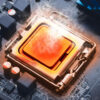It seems like just yesterday when the world leader in flash memory solutions, KIOXIA Corporation, launched fifth-generation BiCS flash 3D NAND memory with a 112-layer, vertically stacked structure. However, that was well over two years ago. Now the organization, in partnership with Western Digital, has announced the sixth-generation of BiCS NAND technology with a whopping 162 layers.
What Is BiCS (Bit Cost Scalable) NAND Flash Memory?
The reason your smartphone can store all the music, pictures, and other types of data in flash memory is because it’s all stored in the form of 0s and 1s. These 0s and 1s are stored in small cells known as memory cells. The more digital data your phone uses, the more data it must store. As a result, the memory capacity must be increased so that more data can be stored in a single flash memory cell.
To meet this larger capacity requirement, miniaturization technology came into play as it allows the area occupied by a single memory cell to be contracted and fit as many cells as possible into one flash memory unit. Unfortunately, this technology was not as efficient as many had hoped; problems like currents flowing due to the close proximity of cells unexpectedly hindered its development. Companies tried to solve this issue by using the traditional planar NAND technology, but it severely limited the memory capacity.
In order to solve all these challenges, BiCS flash memory was created by KIOXIA. BiCS allows the processing time to remain consistent regardless of how many layers are stacked. You could say that BiCS flash is revolutionary in this way because it involves stacking plate electrodes and piercing them so they can pass through, thus creating a memory cell in each layer – rather than stacking memory cells one layer at a time.
Some of the features of BiCS flash memory include:
High Capacity & High Density
It has significantly higher die area density compared to previous (two-dimensional) flash memory. It also uses triple-level cell technology for higher capacity.
Faster Programming Speed
Thanks to wider spaces between memory cells, the data programming speed has improved drastically.
Lower Power Consumption
By increasing the amount of data for faster programming speed, the power consumption per unit has also been reduced.
How Is 6th Generation BiCS Going To Be Different?
The latest generation of BiCS, or as many are referring to it as BiCS 6, is going to have 162 layers and a 40% smaller die than the previous generation BiCS, which had 112 layers. BiCS 6 is also going to introduce innovations in both vertical and lateral scaling to allow for greater memory capacity in a smaller die with fewer layers. This new generation improves many parameters compared to BiCS 5:
- 66% input/output speed increase.
- 10% lower read latency.
- About 2.4 times improvement in program performance through four-plane operation.
- Up to 10% greater density of lateral cell array.
The 162 layers means there is a 44% increase from generation 5 BiCS, which is a much larger increment than in previous generations.
Advanced NAND Flash Solutions in the Storage Industry
If you are looking for custom-configured flash memory devices to fit specialized requirements in encryption, thermal, or endurance, we can help. From data centers to defense organizations, Accelerated Memory Production Inc. has served a variety of industries since 2007. To learn more about our products, please fill out this contact form or call us at 714-460-9800.





